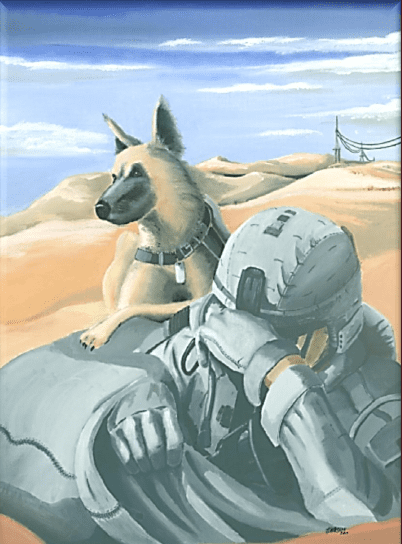
Emily Woodburn
Emily Woodburn grew up as a “military brat” in the Army. Naturally, she called a lot of places home: Germany, Virginia and now Louisville, Kentucky. She earned her BA in general studies with two minors (psychology and veterans studies) as well a certificate in veterans studies in fall 2020. Emily plans to continue her education and serve veterans in the field of nursing. Watching people she loved struggle getting the benefits and health care they deserve made her want to learn more about veterans and ways to serve them. She credits the VTS 200 course for pushing her to pursue her passion for providing high quality care to veterans.
Imagine tossing and turning, screaming your lungs out.
All you see is dust—sand everywhere. It reminds you of the spot where your buddy once stood. There was a warning. But it came too late. And then your friend was gone.
These days, you wake up in cold sweats. Sometimes, you are unsure where you are. Other times, you are in tears. You have no one to comfort you. You feel alone. Worst of all, you are losing the will to fight.
Imagine sitting there, amid all this pain, when suddenly, your best friend jumps on your bed, licking your hand and your face to calm you. He puts pressure on your torso to help. You feel compassion and love.
Your friend is good at what he does. That is because he was continuously trained for more than two years.
The memories will return. But at least your best friend will be there, right behind you, placing a paw on your leg, licking your hand, nudging you to the floor, even lying on you while you calm down if necessary.
Your best friend is a service dog.

Rest, My Friend, I’ll Take Watch from Here. Oil Painting. Timothy Chiasson (Dedicated to the memory of SGT Zaniah Creamer). Published in The Journal of Military Experience, Vol. 2. (c) Eastern Kentucky University
A Needed Distraction
Having a dog who understands emotions helps ground veterans struggling with Post-Traumatic Stress (PTS), and it help helps them feel comfortable in environments that remind them of war. Service dogs provide stability, they reduce suicidal thoughts, and they have been linked to lower rates of substance abuse.
Often, they use their body weight as a grounding mechanism, applying deep pressure stimulation to calm their owners (Beau, 2017). They also learn to lean against their owners, providing a reassuring presence that the veteran may take for granted. For the service animal, these types of behaviors are very intentional. They can sense if the veteran feels unsure or unsafe. Some are trained to enter and scan a room before the owner enters, returning to signal to their handler that it is “all clear.”
Service dogs are specially trained to assist veterans with PTS. However, the process for getting a service dog can be challenging. They often go into debt or fundraise to get the help of these four-legged heroes (O’Haire and Rodriguez, 2018). Shouldn’t service dogs be free? Given public sentiments in the wake of the Iraq and Afghanistan Wars and the prevailing “support the troops” mentality, it seems to be a massive oversight that this proven form of treatment has gone underfunded by major care providers like the VA.
Here are some ways service dogs can help with some symptoms of PTS (Mayo Clinic, 2018):
Intrusive Thoughts / Nightmares– When a veteran is reminded of a troubling memory or is triggered by some unwanted thought, a service dog can sense it. They will often get upon the bed and lick the veteran’s face to distract them. If having nightmares, the dog will do this while nudging the veteran to wake them up. They can also force themselves between the torso and the handler’s arms to prevent self-injury.
Exaggerated Startle Response– Sometimes fireworks, cars backfiring or other loud boom-like noises can escalate PTS symptoms. Service dogs can pick up on these situations immediately and pull their veteran away. The dog might guide the handler away from the area, lay in the their lap, and help them regain their composure.
Avoidance Symptoms– It makes sense to avoid places and things that provoke PTS symptoms. But, over time, this behavior can lead to isolation and an inability to cope with stressful environments. Service dogs can provide an extra sense of security, “sweeping” the area to make the handler feel comfortable, providing a little nibble on the hand to distract the veteran from the sensory overload caused by hypervigilance (Scotland-Coogan, 2019).
Survivor’s Guilt– For many veterans, simply surviving war when others did not can cause its own problems. Having a service dog requires care. Your new “best friend” is a responsibility—a duty. And veterans do not take their duties lightly. Caring for their service animal “forces” veterans fight back against depression by making them leave the house, interact with people at the pet store, and engage with the outside world alongside a source of comfort and security when the mental illness brought on by survivor’s guilt makes it difficult (Dao, 2012).
My Passion
PTS can impact anyone, not just veterans. Civilians may experience it following car accidents (or even witnessing a car accident); it can be the product of sexual assault, childhood abuse, domestic abuse or any number of traumas (Mayo Clinic, 2018). So, when you think about the hypothetical veteran in this article, remember that PTS can happen to anyone. The difference for veterans is that our country has a massive health care system in the Department of Veterans Affairs and taxpayers commit billions of dollars to their care. Service dogs could actually save money while improving quality of life (Lundqvist 2019). How can we make service dogs an easy-to-access treatment?
Programs exist. But many require veterans to enter a waitlist. These former service members spend years waiting, suffering symptoms like the ones listed above, hoping for a source of security or support that is not another prescription medication. Life can deteriorate fast if the symptoms of PTS go unchecked. Divorce, joblessness and even suicide are all tragic outcomes for those veterans dealing with the most extreme symptoms. We should be writing our congresspeople, VA hospitals and Veterans Service Organizations. It is within our power to provide service animals to veterans.
While in VTS 200 Introduction to Veterans Studies, and later when earning my minor in Veterans Studies, I tried to take note of how I could apply what I was learning in my future Nursing career. If you are reading this, I encourage you to explore your passions and put them to work serving veterans. My passion is service animals. I have seen first-hand how they can change lives. So, when given the opportunity, I chose to share some of what I learned.

PTSD. Oil and Mixed Media on Panel (2009), 48 X 64 in., Courtesy Richard Neal. Published in The Journal of Military Experience, Vol. 3. (c) Eastern Kentucky University
References
Beau, E. (2017, June 11). The Empathetic Dog. New York Times, 166(57625), 5.
Dao, J. (2012, April 28). Loyal Companion Helps a Veteran Regain Her Life After War Trauma. New York Times, 161(55756), 18.
Lundqvist, M., Alwin, J., & Levin, L.-Å. (2019). Certified service dogs – A cost-effectiveness analysis appraisal. PLoS ONE, 14(9), 1–13.
Mayo Clinic. (2018, July 06). Post-Traumatic Stress Disorder (PTSD).
O’Haire, M. E., & Rodriguez, K. E. (2018). Preliminary Efficacy of Service Dogs as a Complementary Treatment for Posttraumatic Stress Disorder in Military Members and Veterans. Journal of Consulting & Clinical Psychology, 86(2), 179–188.
Scotland-Coogan, D. (2019). Relationships, Socialization and Combat Veterans: The Impact of Receiving and Training a Service Dog. Qualitative Report, 24(8), 1897–1914.